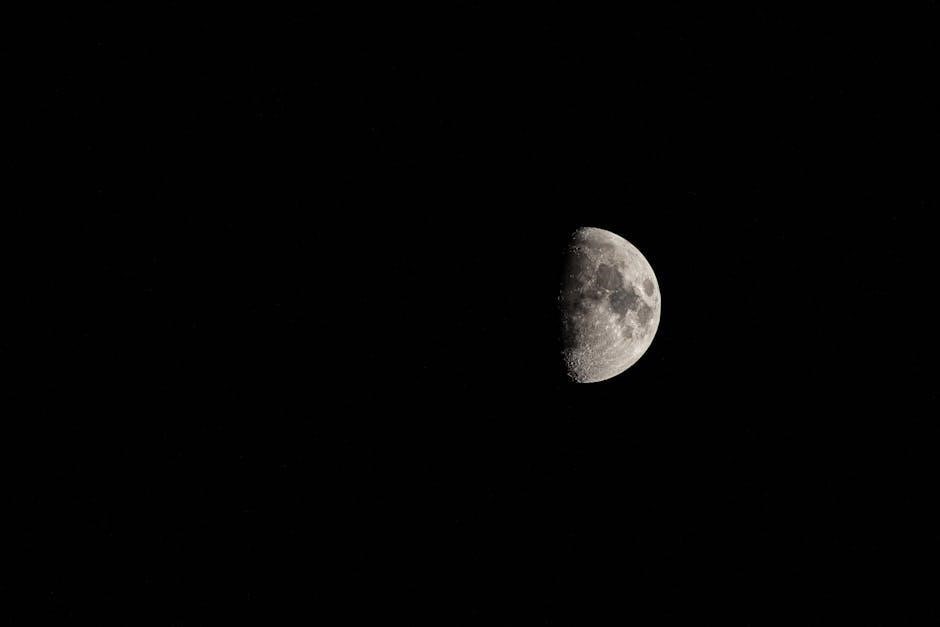The Hitchhiker’s Guide to the Galaxy, written by Douglas Adams, is a groundbreaking science fiction novel first published in 1979. Originating as a BBC radio series, it blends humor and sci-fi, becoming a cult classic. This article explores the significance of its first edition, its cultural impact, and enduring popularity.
Overview of “The Hitchhiker’s Guide to the Galaxy”
The Hitchhiker’s Guide to the Galaxy is a comedic science fiction novel by Douglas Adams, first published in 1979. Originating as a BBC radio series in 1978, the book follows the misadventures of Arthur Dent, an unwitting human, and Ford Prefect, an alien writer for the titular guide. Their journey through space explores themes of humanity, technology, and the absurdity of life. The novel’s unique blend of humor, satire, and sci-fi elements captivated audiences, making it a cult classic. Its success led to a five-part “trilogy” and adaptations across media, cementing its place in pop culture. The first edition, published by Pan Books, remains a sought-after collector’s item, symbolizing the novel’s enduring influence and charm.
Significance of the First Edition
The first edition of The Hitchhiker’s Guide to the Galaxy holds immense historical and cultural value. Published in 1979 by Pan Books, it marked the debut of Douglas Adams’ groundbreaking work, blending humor and science fiction. This edition is particularly rare and sought after by collectors due to its original cover design and printing details. The novel’s initial success was modest, but it quickly gained a cult following, leading to reprints and adaptations. The first edition symbolizes the birth of a beloved franchise, offering insights into Adams’ creative vision. Its rarity and condition significantly impact its value, making it a prized possession for fans and collectors alike, celebrating its enduring legacy in literature and pop culture.

The 1979 First Edition
The Hitchhiker’s Guide to the Galaxy was first published in 1979 by Pan Books in London as a paperback, featuring 158 pages and a distinctive cover design.
Publication Details
The first edition of The Hitchhiker’s Guide to the Galaxy was published on October 12, 1979, by Pan Books in London. Initially released as a paperback, it was priced affordably to reach a broad audience. The book was an adaptation of the first four episodes of Douglas Adams’ 1978 BBC radio series. Pan Books’ edition marked the novel’s debut in print form, quickly gaining traction due to its unique blend of humor and science fiction. This release is often mistakenly attributed to Arthur Barker, but Pan Books holds the distinction of publishing the true first edition, making it highly sought after by collectors today.
First Edition Cover Design
The first edition of The Hitchhiker’s Guide to the Galaxy featured a distinctive cover design that has become iconic. Published by Pan Books in 1979, the cover was simple yet striking, with a yellow background and bold black text. A small, minimalist illustration of a hitchhiking thumb and the words “Don’t Panic!” added to its quirky appeal. This design perfectly encapsulated the book’s blend of humor and science fiction. The cover art has since been celebrated for its understated elegance, making it a recognizable symbol of the novel’s enduring legacy. Its simplicity also contributed to its cult status, resonating with fans of Adams’ unique storytelling style.
Initial Reception and Popularity
The first edition of The Hitchhiker’s Guide to the Galaxy was published on October 12, 1979, and quickly gained a cult following. Its unique blend of humor and science fiction resonated with readers, making it an instant hit. Two days before the official release, Douglas Adams held his first signing at Forbidden Planet in London, signaling early enthusiasm for the book. The novel’s witty storytelling and quirky characters captivated audiences, leading to strong sales and positive reviews. Its popularity grew rapidly, establishing it as a landmark in comedic science fiction. The book’s success was further amplified by its relatable yet absurd narrative, cementing its place as a beloved classic in modern literature. Its enduring appeal continues to attract new readers and fans worldwide.

Author and Creation
Douglas Adams created The Hitchhiker’s Guide to the Galaxy, blending humor with sci-fi, first published in 1979, becoming a cult classic.
Douglas Adams and His Vision
Douglas Adams envisioned The Hitchhiker’s Guide to the Galaxy as a unique blend of humor and science fiction. His creative process began with a radio series for BBC Radio 4 in 1978, which later evolved into the novel. Adams’ vision was to explore the absurdity of life, space, and humanity through a comedic lens. The first edition, published in 1979, encapsulates this vision, offering readers a fresh take on the sci-fi genre. His work quickly gained popularity, solidifying his place as a visionary in both literature and radio.
Origins as a Radio Series
The Hitchhiker’s Guide to the Galaxy originated as a groundbreaking radio comedy series broadcast on BBC Radio 4 in 1978. Created by Douglas Adams, the series blended humor, science fiction, and absurdity, captivating audiences and laying the foundation for the novel. The radio series was a unique blend of storytelling, sound effects, and wit, setting the tone for the book’s eccentric style. Its success on radio led to its adaptation into the first novel, published in 1979. The radio series’ innovative approach to science fiction comedy became the cornerstone of the franchise’s enduring popularity.
Adaptation into a Novel
The radio series’ success led to its adaptation into a novel, published in 1979. Douglas Adams expanded the story, adding depth and humor, while maintaining the quirky charm of the original broadcasts. The novel follows Arthur Dent, Ford Prefect, and their misadventures through space. Its unique blend of wit and science fiction resonated with readers, making it a bestseller. The first edition, published by Pan Books, became a collector’s item. The novel’s adaptation solidified The Hitchhiker’s Guide to the Galaxy as a cult classic, paving the way for further adaptations and cementing its place in science fiction history.

Key Features of the First Edition
The 1979 first edition of The Hitchhiker’s Guide to the Galaxy was published by Pan Books as a paperback, featuring 158 pages. Its iconic cover design and collectibility make it highly sought after by fans and collectors alike.
Printings and Publishing House
The first edition of The Hitchhiker’s Guide to the Galaxy was published by Pan Books in London in 1979. It was released as a paperback, marking the initial printing of the novel. The book, consisting of 158 pages, became widely popular soon after its release. Pan Books played a crucial role in bringing Douglas Adams’ work to the masses, and their edition is now highly sought after by collectors. The first printing is particularly rare and valuable, especially in near-fine condition without inscriptions. Interestingly, the first American edition, published by Harmony Books in 1980, is also notable but distinct from the UK first edition. Both editions are celebrated for their role in launching the series’ global success.
Physical Characteristics of the Book
The first edition of The Hitchhiker’s Guide to the Galaxy is a paperback publication by Pan Books, featuring a distinctive cover design. The book contains 158 pages, with a compact format typical of mass-market paperbacks in the late 1970s. Its physical condition is a critical factor in its value, as the paperback binding and covers are prone to wear and tear. The typography and layout are straightforward, reflecting the era’s publishing standards. The absence of dust jackets in the original paperback edition makes intact, high-grade copies particularly rare. Collectors often seek copies with minimal spine creasing, bright covers, and clean pages to preserve its original charm.
Rarity and Collectibility
The first edition of The Hitchhiker’s Guide to the Galaxy is highly sought after by collectors due to its limited print run and the cultural significance of the novel. Copies in excellent condition, particularly those signed by Douglas Adams, are rare and highly valuable. The paperback format, prone to wear, adds to the challenge of finding pristine copies. Rarity is further compounded by the book’s popularity, as many original copies have been well-read and damaged over the years. As a result, the first edition has become a prized item in science fiction literature, fetching high prices at auctions and among collectors, making it a true gem for enthusiasts of the series.
Cultural Impact
The Hitchhiker’s Guide to the Galaxy became a cultural phenomenon, blending humor and science fiction, influencing TV, radio, and pop culture. Its legacy endures through adaptations, games, and Towel Day celebrations, cementing its place in sci-fi history.
Humor and Science Fiction Blend
The novel masterfully combines humor and science fiction, creating a unique narrative that appeals to fans of both genres. Adams’ witty dialogue, absurd scenarios, and satirical take on human existence captivate readers. The book’s comedic elements, such as the destruction of Earth for a hyperspace bypass or the search for the “Answer to the Ultimate Question of Life, the Universe, and Everything,” are balanced with intelligent storytelling. This blend has made it a cult classic, attracting a diverse audience and inspiring adaptations across media. The humor also includes clever wordplay and absurd characters, like Marvin the Paranoid Android, enhancing the novel’s charm and timeless appeal.
Influence on Pop Culture
The Hitchhiker’s Guide to the Galaxy has left an indelible mark on pop culture. Its unique blend of humor and science fiction inspired countless adaptations, including TV series, films, and video games. The novel’s witty dialogue and iconic characters, such as Marvin the Paranoid Android, have become cultural references. The book’s influence extends to music, comedy, and even technology, with concepts like the “Don’t Panic!” mantra resonating widely. Its impact is evident in shows like The Big Bang Theory, where characters cherish the novel. The creation of Towel Day, celebrated by fans worldwide, further highlights its lasting legacy. The novel’s irreverent style and clever satire continue to inspire creators and entertain audiences globally, cementing its place in pop culture history.
Fandom and Legacy
The Hitchhiker’s Guide to the Galaxy has fostered a dedicated global fandom, with fans celebrating its humor and creativity. The novel’s legacy is marked by annual Towel Day (May 25th), honoring Douglas Adams. Fans worldwide participate in events, showcasing the book’s enduring appeal. The BBC’s 30th-anniversary edition and video game adaptations further cement its cultural significance. Collectors covet rare first editions, while readers continue to discover its timeless wit. The novel’s influence on science fiction and comedy remains unparalleled, ensuring its place as a beloved classic. Its ability to inspire laughter and imagination has created a lasting impact, making it a cherished part of pop culture history.
Other Notable Editions
The 1980 American first edition, published by Harmony Books, and the 1994 Illustrated Edition by Weidenfeld & Nicolson, are notable. Special anniversary editions, like the 30th-anniversary release, also stand out.
1980 American First Edition
The 1980 American first edition of The Hitchhiker’s Guide to the Galaxy was published by Harmony Books. This edition is highly sought after by collectors, especially the first printing, which features distinct typography and a unique dust jacket design. Some copies are signed by Douglas Adams, adding to their rarity and value. The American edition differs slightly from the UK version, with variations in formatting and cover art. Collectors often pursue this edition for its historical significance and the opportunity to own a piece of the novel’s global spread. Its condition and provenance greatly influence its market value, with signed copies fetching premium prices at auctions.
The Illustrated Edition (1994)
The Illustrated Edition of The Hitchhiker’s Guide to the Galaxy, published in 1994 by Weidenfeld & Nicolson, is a visually stunning adaptation of Douglas Adams’ classic novel. This edition features colorful illustrations and unique design elements that bring the story to life. While not a first edition, it stands out for its artistic interpretation of the narrative. Fans and collectors appreciate its creative visuals, which enhance the humor and eccentricity of Adams’ storytelling. This edition is highly collectible, especially in pristine condition, and remains a cherished addition to the franchise’s legacy, offering a fresh way to experience the beloved science fiction tale.
Special and Anniversary Editions
Special and anniversary editions of The Hitchhiker’s Guide to the Galaxy have been released to celebrate milestones in the novel’s history. The 30th Anniversary Edition, for instance, was published in 2009, featuring exclusive content and updated designs. These editions often include forewords, afterwords, or introductions by notable figures, adding depth to the narrative. Some editions are accompanied by commemorative packaging or artwork, making them highly collectible. Additionally, events like Towel Day celebrations have inspired limited-edition releases, further enhancing the book’s cultural appeal. These special editions not only honor the novel’s legacy but also introduce it to new generations of readers, ensuring its timeless relevance. Fans and collectors eagerly seek these unique versions, celebrating Adams’ enduring vision.

Collecting the First Edition
Collecting the first edition of The Hitchhiker’s Guide to the Galaxy is highly sought after by enthusiasts due to its rarity and historical significance in science fiction literature.
Identifying a True First Edition
A true first edition of The Hitchhiker’s Guide to the Galaxy is the 1979 paperback published by Pan Books in London. It features 158 pages and a distinctive cover design by Hipgnosis. Collectors must verify the publisher and publication date, as later editions or reprints may mimic the original. The first printing is highly sought after, with specific details like the absence of inscriptions and a near-fine condition increasing its value. Beware of misleading editions, such as the 1980 American first edition, which is not the original UK printing. Authenticating through reputable dealers or auction houses is advisable to avoid counterfeits. Rarity and demand make this edition a prized collectible.
Condition and Value
The value of a first edition of The Hitchhiker’s Guide to the Galaxy heavily depends on its condition. A near-fine or mint copy, free from wear or damage, retains the highest value. Signed first editions by Douglas Adams are particularly rare and highly sought after, commanding premium prices at auctions. Copies in poor condition, with torn pages or significant wear, are far less valuable. The rarity of pristine copies ensures that well-preserved first editions remain highly desirable among collectors. Auctions have seen signed first editions sell for thousands of dollars, reflecting their cultural significance and the enduring popularity of the novel. Condition is a critical factor in determining the book’s market value.
Market Demand and Auction Highlights
Market demand for the first edition of The Hitchhiker’s Guide to the Galaxy remains robust, driven by its cult following and rarity. Auction highlights include a signed first edition selling for over $10,000, showcasing its desirability. Collectors and fans eagerly seek out near-fine copies, particularly those with original covers and unmarked pages. The novel’s adaptation into various media has further boosted its appeal. Auction houses regularly feature this edition, often exceeding estimated values due to competitive bidding. Such sales underscore the enduring popularity of Douglas Adams’ work and the book’s status as a valuable collectible in the world of science fiction literature.

Unique Aspects of the Novel
The Hitchhiker’s Guide to the Galaxy uniquely blends humor, philosophy, and sci-fi, featuring eccentric characters like Marvin the Android and the innovative Sub-Etha Net concept, creating laugh-out-loud moments.
The Sub-Etha Net and Hitchhiking
The Sub-Etha Net, a faster-than-light communications network, is a central concept in The Hitchhiker’s Guide to the Galaxy, enabling hitchhikers to traverse the galaxy effortlessly. This innovative idea reflects Douglas Adams’ genius in blending humor with sci-fi, creating a unique universe where technology and absurdity coexist. Hitchhiking itself becomes a metaphor for adventure and spontaneity, symbolized by the iconic towel, a must-have item for any intergalactic traveler. The Sub-Etha Net and hitchhiking themes highlight Adams’ ability to craft imaginative, laugh-out-loud moments while exploring deeper philosophical questions about existence and humanity’s place in the cosmos.
Quintessential Eccentricity in Storytelling
Douglas Adams’ The Hitchhiker’s Guide to the Galaxy exemplifies eccentricity in storytelling through its unique blend of humor, absurdity, and clever ideas. The narrative is filled with quirky characters, such as Marvin the Paranoid Android, and bizarre plot twists, like Earth’s destruction to make way for a hyperspace bypass. Adams’ ability to balance the ridiculous with the profound creates a captivating reading experience. The Sub-Etha Net and the search for the “Answer to the Ultimate Question of Life, the Universe, and Everything” (which is 42) showcase his inventive storytelling. This eccentricity has made the book a cult classic, resonating with readers who appreciate its offbeat charm and intellectual humor, cementing its place in science fiction history.
Laugh-Out-Loud Moments
The Hitchhiker’s Guide to the Galaxy is renowned for its hilarious and absurd humor, filled with laugh-out-loud moments that have captivated readers. Douglas Adams’ comedic genius shines through in scenes like Marvin the Paranoid Android’s despairing monologues and the Vogon poetry, often described as the third worst in the universe. The absurdity of hitchhiking through space, the infinite improbability drive, and the super-intelligent shade of the color blue are just a few examples of Adams’ brilliant wit. These moments, blended with clever wordplay and satirical commentary, make the book a joyous read, ensuring its humor remains timeless and universally appealing, even decades after its first publication.
Modern Relevance
The Hitchhiker’s Guide to the Galaxy remains a cultural phenomenon, celebrated through Towel Day (May 25th) and BBC Radio 4 Extra’s 30th-anniversary edition, ensuring its timeless appeal and adaptability for future generations.
Towel Day Celebrations
Towel Day, celebrated annually on May 25th, honors Douglas Adams and The Hitchhiker’s Guide to the Galaxy. Fans worldwide carry towels, a nod to the book’s advice for intergalactic travelers. Events include readings, themed parties, and charity drives. This tradition, launched in 2001, has grown into a global tribute, fostering community among fans. It highlights the novel’s enduring relevance and its ability to inspire joy and creativity. Towel Day also promotes awareness of Adams’ work, ensuring his legacy endures for new generations. The celebration reflects the book’s timeless blend of humor and science fiction, cementing its place in pop culture history.
Radio 4 Extra’s 30th Anniversary Edition
BBC Radio 4 Extra celebrated the 30th anniversary of The Hitchhiker’s Guide to the Galaxy with a special edition broadcast. This tribute honored the original radio series that launched the franchise in 1978. The anniversary edition featured the voices of the original cast, bringing the iconic story to life once more. It included exclusive content, such as behind-the-scenes insights and interviews, offering fans a deeper connection to the story. The broadcast also highlighted the novel’s enduring influence on science fiction and comedy. This celebration not only commemorated the book’s legacy but also introduced it to a new generation of listeners. It remains a testament to the timeless appeal of Douglas Adams’ creation. The event was a fitting tribute to the first edition’s lasting impact.
Future Adaptations and Reprints
As The Hitchhiker’s Guide to the Galaxy continues to captivate audiences, future adaptations and reprints ensure its legacy endures. New radio series and potential film projects are in development, promising fresh interpretations of Douglas Adams’ universe. Special anniversary editions, such as the 30th-anniversary game, keep the story vibrant. Reprints, including signed first editions, remain highly sought after by collectors and fans. These efforts not only celebrate the novel’s origins but also introduce it to new generations. The enduring popularity of the first edition underscores its influence, ensuring that its humor and sci-fi brilliance will remain relevant for years to come. Future adaptations will continue to honor Adams’ vision while exploring new creative avenues.
The first edition of The Hitchhiker’s Guide to the Galaxy remains a cornerstone of science fiction, influencing pop culture and inspiring future adaptations. Its legacy endures.
Enduring Popularity of the First Edition
The first edition of The Hitchhiker’s Guide to the Galaxy continues to captivate fans due to its unique blend of humor and science fiction. Its cult status has grown over decades, with collectors seeking rare copies. The 1979 edition, published by Pan Books, remains highly sought after for its historical significance and nostalgic value. Fans celebrate its influence through events like Towel Day, honoring the book’s iconic advice. The novel’s quirky storytelling and memorable characters ensure its relevance, making it a timeless classic in both literature and pop culture. Its enduring appeal highlights Douglas Adams’ genius in crafting a story that resonates across generations.
Final Thoughts on Its Significance
The Hitchhiker’s Guide to the Galaxy first edition is a landmark in science fiction, blending humor and creativity. Its influence spans literature, radio, and pop culture, cementing its legacy. Douglas Adams’ vision introduced a new way to explore the genre, making it accessible and entertaining. The book’s enduring popularity reflects its timeless appeal, resonating with readers worldwide. As a cultural icon, it continues to inspire adaptations and celebrations, ensuring its place in history. The first edition remains a cherished collector’s item, symbolizing the novel’s impact and the genius of its creator. Its significance is undeniable, leaving a lasting imprint on the world of science fiction and beyond.



